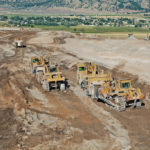- Company: Sunroc
- Industry: Industrial
- Location: Mona, Utah
- Expected Completion Date: December 4, 2015
- Project Website
Phase 1 of Houwelings Mona, Utah sustainable tomato greenhouse consists of a 28.3 acre cutting edge greenhouse located adjacent to a Rocky Mountain
Power gas fired electric generation facility. The two most important inputs for year round growing are heat and CO2. Both of these are waste products from the power plant, and will be 100% utilized by the greenhouse in the production of tomatoes 365 days a year. This greenhouse is expected to provide in excess of 500,000 lbs. of tomatoes weekly year round.
Sunroc Corp. moved approximately 700,000 cubic yards of earth to create the greenhouse pad. Sunroc crews then excavated trenches for the water supply and distribution systems, rainwater collection, and all manner of utility piping in, around, and beneath the
greenhouse. Over 100 miles of piping and conduit were ultimately installed to build the infrastructure for the facility. The project also included more than 6 miles of off site water supply pipelines.
Houwelings proudly likes to share the thought that their Ultra Climate Greenhouse System is incredibly ‘Green’. They claim that the only water that leaves their site is in the tomatoes. It is believed that the greenhouse/power plant connection of this type is the first in the world.
What impact does this project have on America?
The effective safe and sustainable production of food is becoming increasingly difficult in our world today. With this project’s utilization of the capture of 100% of the CO2 (carbon dioxide) emissions from a power plant and channeling them to produce several hundred thousand pounds of ‘table ready’ tomatoes each week of the year is unprecedented. None of the tomatoes produced at this site are processed into foods, but rather all of them are shipped to retailers such as Costco throughout the western U.S., and some as far away as Florida. From the state-of-the-art design of the greenhouse structure to the specialized climate control systems necessary for the sometimes harsh Utah climate this project is a one-of-a-kind. NORTHERN CONSTRUCTION OFFICE: PO BOX 488 SPANISH FORK, UT 84660 801 . 722 . 2100 SUNROC.NET The water supply, recycle, and rainwater collection systems are also unique. Water is supplied, and captured through separate, but connected systems at the tanks. It’s also ‘re-energized’ when it becomes ‘tired’. Above all – It’s Never Wasted.
The plant growing and produce harvesting methods are also very specialized. It has been reported that it would require forty-eight times the land to grow the same volume of tomatoes conventionally given the four distinct seasons in Utah.
What interesting obstacles or unusual circumstances did you overcome to complete the project?
Earthwork – Cuts and fills up to 40 feet. Challenging soil conditions with significant pockets of rock, and occasional boulders several feet in diameter. Very tight time lines required working up to 20 hours per day to deliver the 40 acre precision graded site in less than 90 calendar days.
Pipework – With approximately 100 miles of wet, and dry utility piping/conduit systems beneath the greenhouse the site took on the feel of an enormous ‘Rubik’s Cube’. Making sure that everything ‘fit’ and that nothing got left out became to primary challenge of our international team with members from Holland, Germany and Canada actively involved with local designers and contractors to make sure it all came together as planned. In addition to wrestling with meetings, and conference calls utilizing multiple, and sometimes merged languages, the need to collaborate carefully and meticulously was key to avoiding any overlaps, or worse, gaps in design and/or construction. ‘Teamwork’ was pushed to its ‘Legal Limits’ on more than one occasion.
What dangers and risks did you encounter, and describe any extraordinary methods used to keep workers safe?
Soil conditions, mass earthwork and grading operations coupled with extremely tight scheduling heightened the concern for safe operations. Sunroc worked to insure that workers were given sufficient time to rest and remain mentally sharp. Also, equipment operations were staged to provide safe operating distances from each other, and the crossing of ‘Paths’ (travel ways) was held to a minimum. Regular, detailed safety meetings were held.
Sunroc’s safety record for this project is clean with no recordable, or lost-time accidents. By the time Phase 1 was completed
How did you leverage new technologies to work faster and reduce waste?
Sunroc utilized GPS and 3D modeling to move the earth, and install backbone utilities infrastructure. Laser leveling systems for the greenhouse floor were also employed.
Sunroc field managers utilized iphone and ipad systems for staying up to date with plan revisions, and tracking costs through HCSS products such as HeavyJob.









